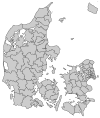Greve Municipality
Greve Municipality
Greve Kommune | |
|---|---|
 | |
 Coat of arms | |
 | |
| Coordinates: 55°35′02″N 12°17′43″E / 55.5839°N 12.2953°ECoordinates: 55°35′02″N 12°17′43″E / 55.5839°N 12.2953°E | |
| Country | Denmark |
| Region | Zealand |
| Established | 1 April 1970 |
| Seat | Greve Strand |
| Government | |
| • Mayor | Pernille Beckmann (V) |
| Area | |
| • Total | 60.18 km2 (23.24 sq mi) |
| Population (1 January 1, 2012) | |
| • Total | 47,936 |
| • Density | 800/km2 (2,100/sq mi) |
| Time zone | UTC+1 (CET) |
| • Summer (DST) | UTC+2 (CEST) |
| Municipal code | 253 |
| Website | www |
Greve Municipality is a municipality (Danish, kommune) about 21 km south-west of Copenhagen in Region Sjælland on the east coast of the island of Zealand (Sjælland) in eastern Denmark. The municipality covers an area of 60 km², and has a total population of 47,773 (2008).
The site of its municipal council is the town of Greve Strand.
It serves primarily as a residential municipality, functioning as a suburb for the larger Copenhagen area.
History[]
Until the 1960s the area was primarily agricultural, and most businesses in town were concentrated along the coastal road "Strandvejen". With numerous holiday cottages near the coast of Køge Bugt (Køge Bay), this was also the destination for many inhabitants of Copenhagen on holiday away from the hustle and bustle of the city.
During the late 1960s and into the 1970s, many people moved permanently out of Copenhagen and into new homes in places like Greve. What was formerly farmers' fields quickly turned into districts of detached houses, whilst most of the shops and similar businesses near the coastal road moved into central shopping malls such as Hundige Storcenter and . Around 1980 the S-train railroad network was expanded towards Køge, and the stations Greve and Hundige were placed adjacent to the shopping malls.
Greve Municipality was formed in 1970, as part of the kommunalreform ("Municipal Reform") of that year. It was established by combining the following parishes:
- Greve
- Hundige
- Karlslunde
- Karlslunde Strand
- Kildebrønde
- Mosede
- Tune.
Greve municipality was one of the municipalities that was not merged 1 January 2007 in the nationwide Kommunalreformen ("The Municipal Reform" of 2007).
Locations[]
| Greve Strand | 43,300 |
| Tune | 5,300 |
| 720 | |
| 380 |
Politics[]
Greve's municipal council consists of 21 members, elected every four years. The municipal council has six political committees.[1]
National results[]
| Blue Bloc | Red Bloc | Other | |
|---|---|---|---|
| 1998[2] | 17,629 (58.5%) | 12,429 (41.3%) | 63 (0.2%) |
| 2001[3] | 20,235 (65.7%) | 10,542 (34.3%) | 0 (0%) |
| 2005[4] | 18,764 (64.2%) | 10,109 (34.6%) | 355 (1.2%) |
| 2007[5] | 19,482 (64.9%) | 10,558 (35.1%) | 0 (0%) |
| 2011[5] | 18,938 (62.2%) | 11,529 (37.8%) | 4 (0%) |
| 2015[5] | 18,986 (62.5%) | 11,369 (37.4%) | 16 (0.1%) |
| 2019[5] | 15,658 (51.6%) | 13,147 (43.3%) | 1,552 (5.1%) |
Municipal council[]
Below are the municipal councils elected since the Municipal Reform of 2007.
| Election | Party | Total seats |
Turnout | Elected mayor | |||||||||
|---|---|---|---|---|---|---|---|---|---|---|---|---|---|
| A | B | C | F | I | O | V | Ø | ||||||
| 2005 | 6 | 1 | 2 | 1 | 2 | 9 | 21 | 68.8% | (C) | ||||
| 2009 | 5 | 4 | 2 | 2 | 8 | 67.0% | |||||||
| 2013 | 5 | 2 | 1 | 3 | 9 | 1 | 74.2% | (V) | |||||
| 2017 | 7 | 1 | 1 | 2 | 9 | 1 | 71.3% | ||||||
| Data from Kmdvalg.dk 2005, 2009, 2013 and 2017 | |||||||||||||
References[]
- ^ Greve.dk "Byråd og udvalg" Retrieved 28 April 2019
- ^ "Folketingsvalget den 11. marts 1998" (PDF) (in Danish). pp. 78 & 88. Retrieved 18 November 2019.
- ^ (PDF). pp. 74 & 84 https://sim.dk/media/15137/folketingsvalget-den-20-november-2001.pdf. Retrieved 18 November 2019. Missing or empty
|title=(help) - ^ "Folketingsvalget den 8. februar 2005" (PDF) (in Danish). p. 97. Retrieved 18 November 2019.
- ^ Jump up to: a b c d "Election to the Parliament by result of the election and municipalities (2007-2019)". Statistics of Denmark. Retrieved 18 November 2019.
- Municipal statistics: NetBorger Kommunefakta, delivered from KMD aka Kommunedata (Municipal Data)
- Municipal mergers and neighbors: Eniro map with named municipalities
External links[]
| Wikimedia Commons has media related to Greve Kommune. |
- Official website
- Krak searchable/printable map (in Danish)
- Greve Municipality
- Municipalities of Region Zealand
- Municipalities of Denmark
- Copenhagen metropolitan area

